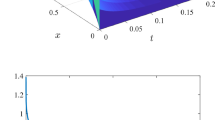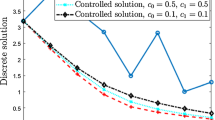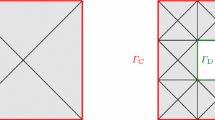Abstract
A Lagrange-Newton-SQP method is analyzed for the optimal control of the Burgers equation. Boundary controls are given, which are restricted by pointwise lower and upper bounds. The convergence of the method is proved in appropriate Banach spaces. This proof is based on a second-order sufficient optimality condition and the theory of Newton methods for generalized equations in Banach spaces. For the numerical realization a primal-dual active set strategy is applied. To illustrate the theoretical investigations, numerical examples are included. Moreover, a globalization technique for the SQP method is tested numerically.
Similar content being viewed by others
References
H.W. Alt, Lineare Funktionalanalysis. Eine anwendungsorientierte Einführung, Springer-Verlag: Berlin, 1992.
W. Alt, “The Lagrange-Newton method for infinite-dimensional optimization problems,” Numerical Functional Analysis and Optimization, vol. 11, pp. 201-224, 1990.
M. Bergounioux, M. Haddou, M. Hintermüller, and K. Kunisch, “A comparison of interior point methods and a Moreau-Yosida based active set strategy for constrained optimal control problems,” SIAM J. Optimization, vol. 11, pp. 495-521, 2000.
M. Bergounioux, K. Ito, and K. Kunisch, “Primal-dual strategy for constrained optimal control problems,” SIAM J. Control and Optimization, vol. 37, pp. 1176-1194, 1999.
R. Dautray and J.-L. Lions, Mathematical Analysis and Numerical Methods for Science and Technology, vol. 5: Evolution Problems I, Springer-Verlag: Berlin, 1992.
E. DiBenedetto, Degenerate Prabolic Equations, Springer-Verlag: New York, 1993.
A.L. Dontchev, “Local analysis of a Newton-type method based on partial linearization,” in Proceedings of the AMS-SIAM Summer Seminar in Applied Mathematics on Mathematics and Numerical Analysis: Real Number Algorithms, vol. 32, J. Renegar, M. Shub, and S. Smale (Eds.), AMS Lectures in Appl. Math., 1996, pp. 295-306.
H. Goldberg and F. Tröltzsch, “On the Lagrange-Newton-SQP method for the optimal control of semilinear parabolic equations,” Optimization Methods and Software, vol. 8, pp. 225-247, 1998.
W.W. Hager, “Multiplier methods for nonlinear optimal control,” SIAM J. Numerical Analysis, vol. 27, pp. 1061-1080, 1990.
W.W. Hager and G. Ianculescu, “Dual approximations in optimal control,” SIAM J. Control Optim., vol. 22, pp. 423-465, 1984.
W.W. Hager, “The dual active set algorithm,” in Advances in Optimization and Parallel Computing, P.M. Pardalos (Ed.), North Holland: Amsterdam, 1992, pp. 137-142.
W.W. Hager and D. Hearn, “The dual active set algorithm applied to quadratic networks,” Computational Optimization and Applications, vol. 1, pp. 349-373, 1993.
M. Hintermüller, “A primal-dual active set algorithm for bilaterally control constrained optimal control problems,” Quarterly of Applied Mathematics, to appear.
M. Hintermüller, “On a globalized augmented Lagrangian-SQP algorithm for nonlinear optimal control problems with box constraints,” in Proceedings of the Workshop, Fast Solution of Discretized Optimization Problems, Weierstrass Institute for Applied Analysis and Stochastics, Berlin, 2002, pp. 139-153.
M. Hintermüller and M Hinze, “Globalization of SQP methods in control of the instationary Navier-Stokes equations,” Technical Report No. 224, Special Research Center F 003, Optimization and Control, Project area Continuous Optimization and Control, University of Graz & Technical University of Graz, August 2001, submitted.
K. Kunisch and A. Rösch, “Primal-dual strategy for constrained parabolic optimal control problems,” Technical Report No. 154, Special Research Center F 003 Optimization and Control, Project area Continuous Optimization and Control, University of Graz & Technical University of Graz, June 1999, to appear in SIAM J. Optimization.
S.M. Robinson, “Strongly regular generalized equations,” Mathematics of Operation Research, vol. 5, pp. 43-62, 1980.
R. Temam, Infinite-Dimensional Dynamical Systems in Mechanics and Physics, vol. 68 of Applied Mathematical Sciences. Springer-Verlag: New York, 1988.
F. Tröltzsch, “On the Lagrange-Newton-SQP method for the optimal control of semilinear parabolic equations,” SIAM J. Control and Optimization, vol. 38, pp. 294-312, 1999.
F. Tröltzsch, “Lipschitz stability of solutions to linear-quadratic parabolic control problems with respect to perturbations,” Dynamics of Continuous, Discrete and Impulsive Systems, vol. 7, pp. 289-306, 2000.
F. Tröltzsch and S. Volkwein, “The SQP method for control constrained optimal control of the Burgers equation,” ESAIM: Control, Optimisation, and Calculus of Variations, vol. 6, pp. 649-674, 2001.
S. Volkwein, “Mesh-independence of an augmented Lagrangian-SQP method in Hilbert spaces and control problems for the Burgers equation,” PhD Thesis, Department of Mathematics, Technical University of Berlin, Oct. 1997.
S. Volkwein, “Second-order conditions for boundary control problems of the Burgers equation,” Control and Cybernetics, vol. 30, pp. 249-278, 2001.
S. Volkwein, “Mesh-independance of Lagrangian-SQP methods with Lipschitz-continuous Lagrange multiplier updates,” Technical Report No. 205, Special Research Center F 003 Optimization and Control, Project area Continuous Optimization and Control, University of Graz & Technical University of Graz, Nov. 2000, to appear in Optimization Methods and Software.
S. Volkwein, “Boundary control of the Burgers equation: Optimality conditions and reduced-order approach,” in Optimal Control of Complex Dynamical Structures, K.-H. Hoffmann, I. Lasiecka, G. Leugering, J. Sprekels, and F. Tröltzsch (Eds.), International Series of Numerical Mathematics, vol. 139, pp. 267-278, 2001.
S. Volkwein, Optimal and Suboptimal Control of Partial Differential Equations: Augmented Lagrange-SQP Methods and Reduced-Order Modeling with Proper Orthogonal Decomposition, Grazer Mathematische Berichte, 2001.
S. Volkwein and M. Weiser, “Affine invariant convergence analysis for inexact augmented Lagrangian-SQP methods,” SIAM J. Contr. Optim., to appear.
W. Walter, Gewöhnliche Differentialgleichungen, Eine Einführung, Springer-Verlag: Berlin, 1980.
Author information
Authors and Affiliations
Rights and permissions
About this article
Cite this article
Volkwein, S. Lagrange-SQP Techniques for the Control Constrained Optimal Boundary Control for the Burgers Equation. Computational Optimization and Applications 26, 253–284 (2003). https://doi.org/10.1023/A:1026047622744
Issue Date:
DOI: https://doi.org/10.1023/A:1026047622744




